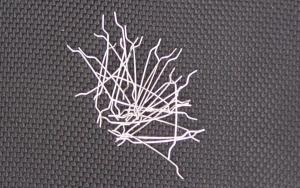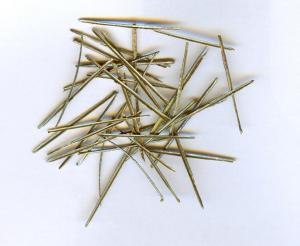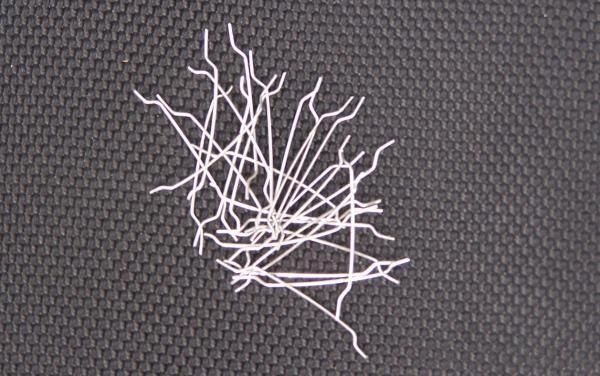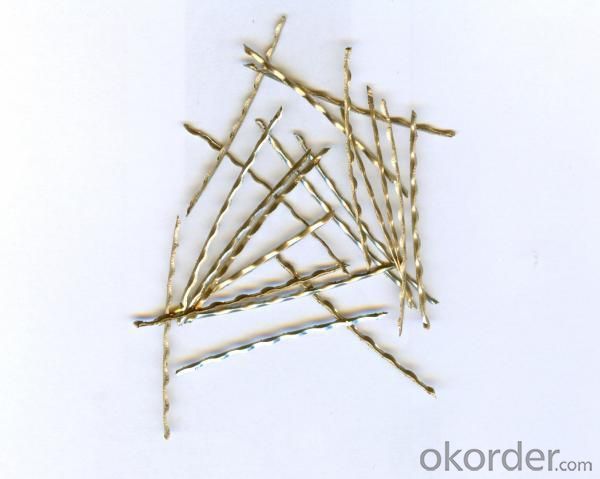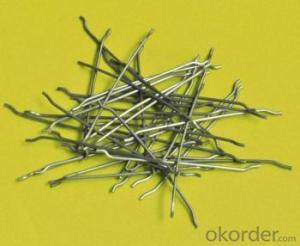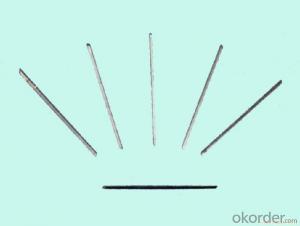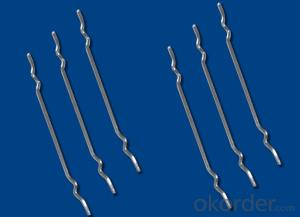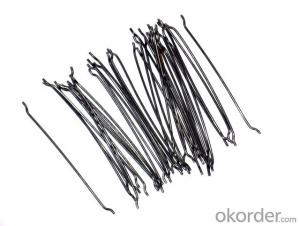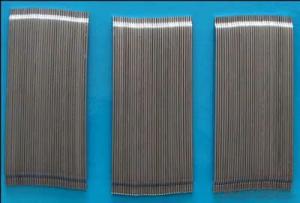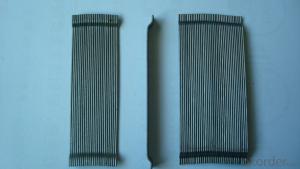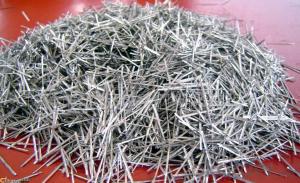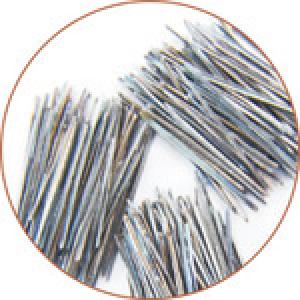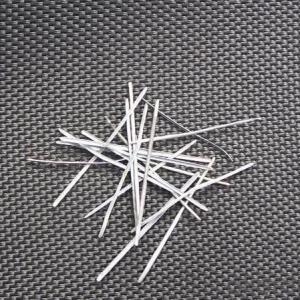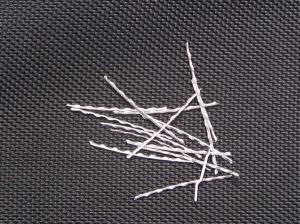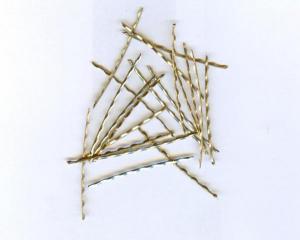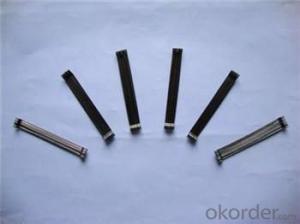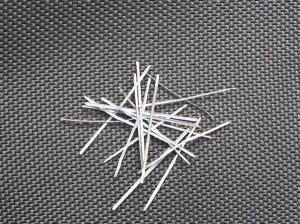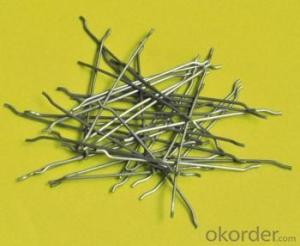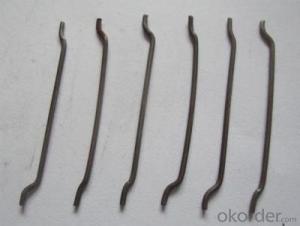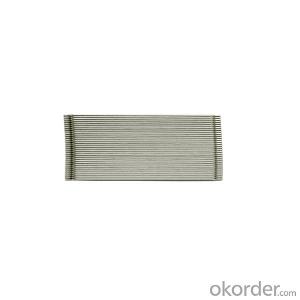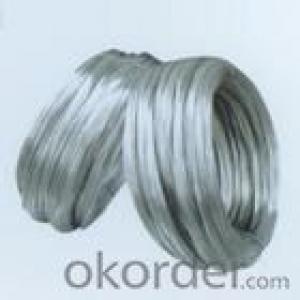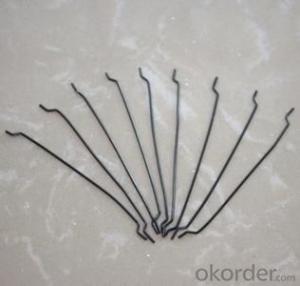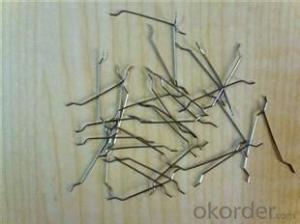Melt Extract Stainless Steel Fiber 430
- Loading Port:
- China Main Port
- Payment Terms:
- TT or L/C
- Min Order Qty:
- 5 Tons m.t.
- Supply Capability:
- 5000 Tons per Month m.t./month
OKorder Service Pledge
OKorder Financial Service
You Might Also Like
General Information of Melt Extract Stainless Steel Fiber 430
CMAX melt extract stainless steel fibers not only allow for more user-friendly than the stiff cut fibers ,but also have better flow features.Melt extract stainless steel fiber is produced by melting elements in a crucible. A flywheel is then introduced to the crucible and droplets of molten metal are spun into the open air and hardened.The speed of the wheel determines the fiber length. CMAX melt extract stainless steel fiber can increase the lifetime of refractory materials and industrial furnaces by several times, decreasing cost. It has outstanding performances in thermal shock resistance.
Feature of CMAX Melt Extract Stainless Steel Fiber 430
Improve refractories’performance
Improve refractories’longevity
Improve refractories’durability
Significantly reducing downtime and maintance cost
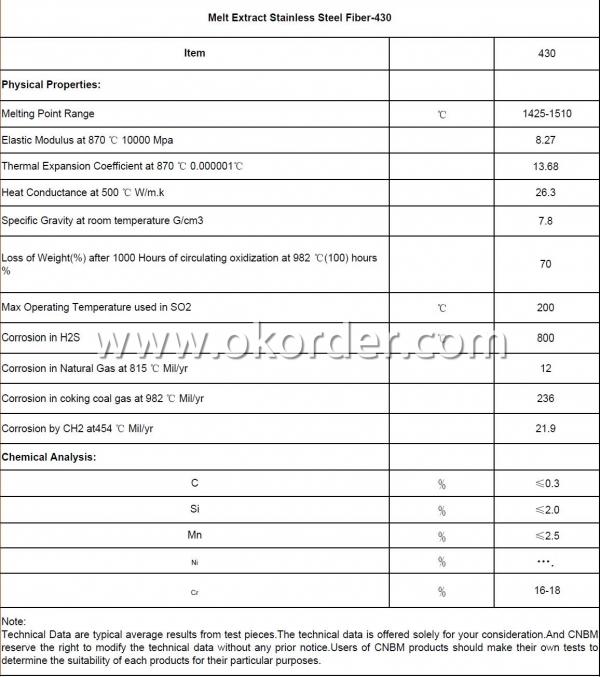
Application of CMAX Melt Extract Stainless Steel Fiber 430
Refractory products
Precast
Castable project
Industrial furnaces
Other refractories project
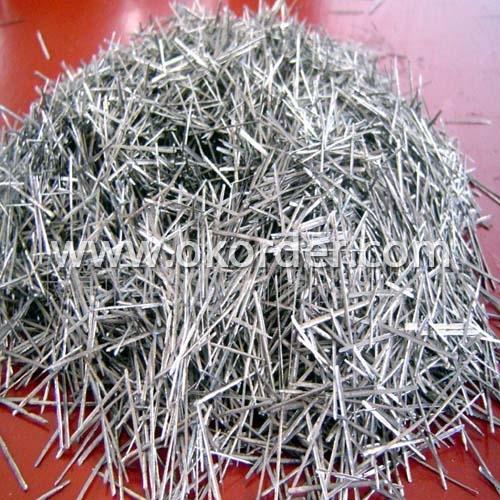

Our company has success in its melt extract stainless steel fibe rproducts due to their cost-effectiveness and excellent insulating properties. We also have experience in melt extract stainless steel fiber application and would like to assist you in product selection, system design, and installation techniques. Our products of melt extract stainless steel fiber are in good quality and in best price. We can serve many products in your satisfaction.
- Q: How does melt extract stainless steel fiber impact the workability of concrete?
- The workability of concrete is significantly affected by the inclusion of melt extract stainless steel fiber. By adding these fibers to concrete mixtures, the overall workability and cohesiveness of the mix are enhanced, making it easier to handle and shape. A key advantage of utilizing melt extract stainless steel fiber is its ability to enhance the plasticity of the concrete. Acting as reinforcement, the fibers distribute the load throughout the mix, reducing the likelihood of cracking and shrinkage. This leads to a more manageable and pliable concrete mix, facilitating better construction and finishing. Furthermore, the incorporation of stainless steel fibers also improves the overall strength and durability of the concrete. Serving as reinforcement, the fibers provide additional tensile strength and prevent crack formation. This not only improves the workability of the concrete but also enhances its resistance to impact, vibrations, and other external forces. In addition, melt extract stainless steel fibers boost the cohesion and cohesiveness of the concrete mix. These fibers establish a three-dimensional network within the concrete, aiding in holding the mixture together and reducing segregation and bleeding. Consequently, a more uniform and homogeneous concrete mix is achieved, making it easier to pour, spread, and finish. Overall, the introduction of melt extract stainless steel fiber has a positive impact on the workability of concrete, improving its plasticity, strength, and cohesion. It elevates the characteristics of handling and shaping in the concrete mix, resulting in enhanced construction quality and increased durability.
- Q: Are there any specific curing requirements for concrete with melt extract stainless steel fiber?
- Concrete with melt extract stainless steel fiber has specific curing requirements that need to be addressed. It is important to understand that the inclusion of stainless steel fibers in concrete can greatly improve its mechanical properties, such as tensile strength and resistance to cracking. However, these fibers can also impact the curing process, necessitating certain considerations. One crucial requirement is the need for adequate moisture during the curing process. It is essential to keep concrete with stainless steel fibers moist to prevent premature drying, which can result in shrinkage and cracking. To retain moisture and ensure proper hydration, moist curing methods like using wet burlap or plastic sheets can be employed. Temperature control is another critical aspect of the curing period. High temperatures can accelerate the hydration process, leading to increased shrinkage and potential cracking. Conversely, low temperatures can hinder curing and result in reduced strength development. Therefore, maintaining a moderate and consistent temperature is vital for the proper curing of concrete with stainless steel fibers. Moreover, it is advisable to prolong the duration of the curing period for concrete with stainless steel fibers. The presence of fibers can impede water movement within the concrete matrix, slowing down hydration. By extending the curing time, the concrete has more opportunity to develop the desired strength and durability. Lastly, it is crucial to adhere to the manufacturer's recommendations regarding curing requirements for concrete with melt extract stainless steel fibers. Different fiber types and manufacturers may have specific guidelines and recommendations for curing, which should be followed to ensure optimal performance of the concrete. To summarize, the curing requirements for concrete with melt extract stainless steel fibers involve maintaining moisture, controlling temperature, extending the curing period, and following manufacturer guidelines. By fulfilling these requirements, the concrete can achieve its desired strength and durability while benefiting from the enhanced properties provided by the stainless steel fibers.
- Q: Can melt extract stainless steel fiber be used in composite materials or fiber-reinforced polymers?
- Composite materials or fiber-reinforced polymers can benefit from the utilization of melt extract stainless steel fiber. These fibers possess excellent attributes, including high strength, resistance to corrosion, and thermal stability. Consequently, they are ideal for reinforcing a wide range of applications. When incorporated into composite materials or fiber-reinforced polymers, stainless steel fibers augment mechanical properties such as tensile strength, stiffness, and impact resistance. Furthermore, they contribute to the long-lasting nature and dimensional stability of the composite material. Moreover, the electrical conductivity of stainless steel fibers can prove advantageous in specific scenarios. Ultimately, the application of melt extract stainless steel fiber in composite materials or fiber-reinforced polymers yields enhanced performance and functionality.
- Q: Can melt extract stainless steel fiber be used in self-compacting concrete?
- Yes, melt extract stainless steel fiber can be used in self-compacting concrete. Self-compacting concrete (SCC) is a specialized type of concrete that is highly fluid and able to flow and fill complex forms without the need for vibration. It is typically used in applications where traditional concrete pouring methods are not feasible. Adding stainless steel fibers to SCC can provide several benefits, including increased tensile and flexural strength, improved crack resistance, and enhanced durability. The use of stainless steel fibers can also help control shrinkage and reduce the likelihood of plastic shrinkage cracking. Melt extract stainless steel fibers are specifically designed for use in concrete applications. They are produced by melting stainless steel and then rapidly cooling and solidifying it to create thin, elongated fibers. These fibers are typically added to the concrete mixture during the mixing process. The addition of melt extract stainless steel fibers can help enhance the overall performance and structural integrity of self-compacting concrete, making it a suitable choice for various construction projects. However, it is important to consult with a structural engineer or concrete specialist to determine the appropriate fiber dosage and ensure compatibility with the specific SCC mix design.
- Q: What is the effect of melt extract stainless steel fiber on the crack width in shotcrete?
- The use of melt extract stainless steel fiber in shotcrete has a significant effect on the crack width in the material. Stainless steel fibers are known for their high tensile strength and durability, making them an ideal reinforcement material for shotcrete applications. When added to the shotcrete mix, the stainless steel fibers are uniformly distributed throughout the material, creating a network of reinforcement that enhances its structural integrity. This reinforcement helps to reduce the crack width in the shotcrete, as the fibers effectively bridge the cracks and prevent their propagation. The melt extract stainless steel fibers act as micro-reinforcement within the shotcrete, increasing its ductility and resistance to cracking. This is particularly beneficial in areas with high stress concentrations or where cracking is a common issue, such as in tunnels, underground structures, or retaining walls. By reducing the crack width in shotcrete, the use of melt extract stainless steel fibers improves the overall durability and longevity of the material. It enhances its resistance to environmental factors, such as freeze-thaw cycles, chemical exposure, or mechanical loading, which can lead to crack propagation and subsequent deterioration. Furthermore, the reduced crack width in shotcrete also improves its aesthetic appearance, as it minimizes the visible signs of cracking on the surface. This is particularly important in architectural applications where the shotcrete is left exposed and serves as a decorative element. In summary, the addition of melt extract stainless steel fibers to shotcrete has a positive effect on the crack width in the material. It improves its structural integrity, durability, resistance to cracking, and overall aesthetic appearance, making it a valuable reinforcement option for shotcrete applications.
- Q: How does melt extract stainless steel fiber improve the durability of sprayed concrete?
- The durability of sprayed concrete is significantly enhanced by melt extract stainless steel fiber. These fibers play a vital role in reinforcing the concrete matrix, effectively boosting its tensile strength and resistance to cracking. This is especially important in high-pressure application techniques used in sprayed concrete, as it is prone to shrinkage and cracking. Furthermore, stainless steel fibers possess unique properties, such as high corrosion resistance, which safeguard the concrete from environmental factors that can deteriorate its durability. They are highly resistant to rust and other forms of corrosion, offering particular advantages in harsh or corrosive surroundings. Additionally, the presence of these fibers improves the impact resistance of sprayed concrete. Due to their strength and flexibility, they can absorb and distribute energy when subjected to impact or dynamic loads, decreasing the risk of surface spalling or cracking. Moreover, melt extract stainless steel fibers enhance the overall cohesion and bond strength between the sprayed concrete and the substrate. This is crucial in sprayed concrete applications, ensuring a robust connection between the concrete and the applied surface, minimizing the risk of delamination or detachment. In conclusion, melt extract stainless steel fiber enhances the durability of sprayed concrete by improving its tensile strength, resistance to cracking, impact resistance, corrosion resistance, and overall bond strength. These fibers provide essential reinforcement to the concrete matrix, making it more resilient and extending its service life in a variety of challenging environments and applications.
- Q: How does melt extract stainless steel fiber affect the abrasion resistance of concrete?
- Concrete's abrasion resistance can be significantly improved by incorporating melt extract stainless steel fiber. These fibers create a three-dimensional reinforcement network within the concrete, enhancing its strength and durability. The unique properties of stainless steel, such as its high tensile strength and corrosion resistance, contribute to the improved abrasion performance. The addition of these fibers helps prevent the formation of microcracks and control the propagation of existing cracks in the concrete. As a result, the concrete becomes more resistant to wear and tear caused by abrasion. The fibers act as reinforcement, strengthening the concrete by bridging gaps between aggregates and providing additional tensile strength. By incorporating stainless steel fibers, the concrete gains increased resistance to surface erosion, impact, and friction. This is particularly beneficial in high-traffic areas like industrial floors, highways, parking lots, and airports, where abrasion is common. The improved abrasion resistance ensures that the concrete remains intact and maintains its structural integrity over a longer period. Moreover, melt extract stainless steel fibers also extend the overall lifespan of concrete structures. By reducing the need for repairs and maintenance due to abrasion damage, these fibers help save costs and minimize environmental impact. To summarize, melt extract stainless steel fiber greatly enhances concrete's abrasion resistance by reinforcing the material, reducing crack formation, and improving its strength and durability. This makes it an excellent choice for applications where abrasion is a concern, resulting in longer-lasting and more resilient concrete structures.
- Q: Does melt extract stainless steel fiber improve the fatigue resistance of concrete?
- Concrete can be improved in terms of fatigue resistance by adding melt extract stainless steel fiber. These fibers are known for their high tensile strength and excellent corrosion resistance. When incorporated into concrete, they serve as reinforcement and help distribute stress more evenly, reducing the chances of cracking and failure under cyclic loading conditions. The inclusion of melt extract stainless steel fiber in concrete significantly boosts its ability to withstand fatigue. These fibers absorb and dissipate energy during loading and unloading cycles, reducing the accumulation of microcracks and increasing the overall durability of the concrete. This enhanced fatigue resistance is particularly advantageous for structures subjected to repetitive or dynamic loading, such as bridges, pavements, and industrial floors. Moreover, melt extract stainless steel fibers possess a high aspect ratio, meaning they have a relatively long length compared to their diameter. This characteristic allows the fibers to effectively bridge cracks that may occur in the concrete, preventing their propagation and enhancing the structural integrity of the material as a whole. In conclusion, the addition of melt extract stainless steel fiber greatly enhances the fatigue resistance of concrete, making it more capable of withstanding cyclic loading. This reinforcement prevents the formation and spread of cracks, resulting in a more durable and long-lasting concrete structure.
- Q: How is the dosage of melt extract stainless steel fiber determined for concrete reinforcement?
- The amount of melt extract stainless steel fiber used for reinforcing concrete depends on several factors, including project requirements, the type of concrete, and desired concrete properties. To determine the dosage, extensive testing and analysis are typically conducted to ensure that the reinforced concrete meets the desired performance criteria. The dosage is usually expressed as a percentage of the weight or volume of the concrete relative to the stainless steel fiber. The first step is to evaluate the project requirements, such as the design strength, durability, and crack resistance of the concrete. This information helps identify the necessary properties that the stainless steel fiber should provide. Laboratory testing is then performed to assess the compatibility between the stainless steel fiber and the concrete mix. This includes evaluating the bonding characteristics, dispersibility, and the impact on the fresh and hardened properties of the concrete. The dosage is adjusted based on the test results to optimize the performance of the reinforced concrete. The type of concrete being used also influences the dosage. Different concrete mixes have different characteristics, such as aggregate sizes, water-cement ratios, and admixtures. These factors affect the amount of stainless steel fiber required to achieve the desired properties. Additionally, the desired properties of the reinforced concrete, such as flexural strength, impact resistance, and crack control, also impact the dosage. Applications that require superior performance in these properties generally require higher dosages of stainless steel fiber. It is important to carefully determine the dosage to avoid negative effects on the workability of the concrete mix. Excessive dosages can make it difficult to place and finish the concrete and may cause segregation or clumping of the fiber. In conclusion, determining the dosage of melt extract stainless steel fiber for concrete reinforcement involves analyzing project requirements, concrete characteristics, and desired properties. Through extensive testing and evaluation, the dosage is optimized to effectively enhance the performance of the concrete.
- Q: How does melt extract stainless steel fiber improve the impact resistance of concrete pipes?
- Concrete pipes commonly utilize melt extract stainless steel fiber as a reinforcing material to enhance their impact resistance. By adding these fibers to the concrete mixture, the overall performance and durability of the pipes are significantly improved. The impact resistance of concrete pipes is primarily enhanced by melt extract stainless steel fiber through its ability to distribute and dissipate energy upon impact. When a force is applied to the pipe, the fibers act as mini-reinforcements within the concrete matrix, effectively absorbing and dispersing the energy throughout the structure. This mechanism of energy dispersion prevents the concentration of stress in specific areas of the pipe, reducing the likelihood of cracks or fractures forming upon impact. By evenly distributing the energy, the stainless steel fibers increase the overall strength and resilience of the concrete pipe, making it more capable of withstanding heavy loads and external forces. Additionally, the high tensile strength of melt extract stainless steel fibers further contributes to the improved impact resistance of the concrete pipes. These fibers are typically manufactured with a diameter ranging from 0.1mm to 0.5mm and possess excellent tensile strength properties. As a result, they provide an additional layer of reinforcement to the concrete, effectively reinforcing the matrix and making it more resistant to impact-induced damage. Furthermore, melt extract stainless steel fibers also enhance the durability of the concrete pipes by preventing the propagation of cracks. In the event of an impact, the fibers act as bridging elements across cracks, inhibiting their growth and preventing them from spreading further. This crack inhibition property significantly improves the overall integrity of the pipe, reducing the risk of failure and extending its service life. In conclusion, melt extract stainless steel fiber improves the impact resistance of concrete pipes through energy distribution, increased tensile strength, and crack prevention. These fibers play a vital role in enhancing the overall durability and performance of concrete pipes, enabling them to withstand external forces and heavy loads more effectively.
1. Manufacturer Overview
| Location | Henan, China |
| Year Established | 2007 |
| Annual Output Value | Above US$ 200 Million |
| Main Markets | North America;Asia;Western Europe;Africa;Russia;Middle East |
| Company Certifications | ISO 9001:2008 |
2. Manufacturer Certificates
| a) Certification Name | |
| Range | |
| Reference | |
| Validity Period |
3. Manufacturer Capability
| a) Trade Capacity | |
| Nearest Port | Tianjin |
| Export Percentage | 20% - 30% |
| No.of Employees in Trade Department | 10-20 People |
| Language Spoken: | English; Chinese |
| b) Factory Information | |
| Factory Size: | Above 150,000 square meters |
| No. of Production Lines | Above 10 |
| Contract Manufacturing | Installation guide, OEM Service Offered |
| Product Price Range | High; Average |
Send your message to us
Melt Extract Stainless Steel Fiber 430
- Loading Port:
- China Main Port
- Payment Terms:
- TT or L/C
- Min Order Qty:
- 5 Tons m.t.
- Supply Capability:
- 5000 Tons per Month m.t./month
OKorder Service Pledge
OKorder Financial Service
Similar products
Hot products
Hot Searches
Related keywords
